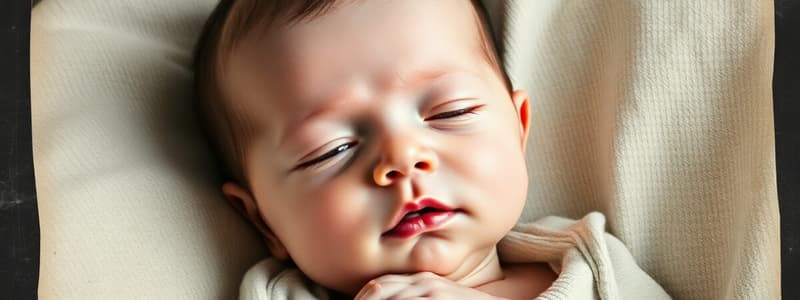Podcast
Questions and Answers
What is the average birth weight of a full-term newborn in developed countries?
What is the average birth weight of a full-term newborn in developed countries?
- 5.0 kg
- 2.0 kg (correct)
- 4.0 kg
- 3.5 kg
What percentage of body weight do term neonates typically lose in the first few days after birth?
What percentage of body weight do term neonates typically lose in the first few days after birth?
- 3-7% (correct)
- 5-10%
- 7-10%
- 1-3%
What is a characteristic of lanugo hair in newborns?
What is a characteristic of lanugo hair in newborns?
- It is thick and coarse.
- It is present only in male newborns.
- It appears only in full-term babies.
- It usually disappears in the first week of life. (correct)
Which of the following skin features is commonly seen in premature babies?
Which of the following skin features is commonly seen in premature babies?
At what age do Mongolian spots typically disappear?
At what age do Mongolian spots typically disappear?
What is the primary function of the anterior fontanel?
What is the primary function of the anterior fontanel?
At what age does the posterior fontanel typically close?
At what age does the posterior fontanel typically close?
Which reflex is characterized by the baby extending and abducting its arms and legs in response to a sudden stimulus?
Which reflex is characterized by the baby extending and abducting its arms and legs in response to a sudden stimulus?
What indicates normal function of the nervous system in a newborn?
What indicates normal function of the nervous system in a newborn?
Which of the following is NOT a primitive reflex related to feeding?
Which of the following is NOT a primitive reflex related to feeding?
Which reflex involves a baby turning its head towards a stimulus when the cheek is touched?
Which reflex involves a baby turning its head towards a stimulus when the cheek is touched?
At what age do most primitive reflexes related to feeding typically disappear?
At what age do most primitive reflexes related to feeding typically disappear?
What is the normal body temperature range for a newborn baby?
What is the normal body temperature range for a newborn baby?
Which reflex occurs when a baby experiences a foreign body in the upper respiratory tract?
Which reflex occurs when a baby experiences a foreign body in the upper respiratory tract?
What is the normal heart rate range for a newborn baby?
What is the normal heart rate range for a newborn baby?
What is the normal range for respiratory rate in beats per minute?
What is the normal range for respiratory rate in beats per minute?
Which muscle groups are primarily involved in monitoring respiration?
Which muscle groups are primarily involved in monitoring respiration?
What might indicate an abnormal respiratory rate?
What might indicate an abnormal respiratory rate?
Identifying which of the following is essential for monitoring proper respiration?
Identifying which of the following is essential for monitoring proper respiration?
Which of the following respiratory rates would indicate hyperventilation?
Which of the following respiratory rates would indicate hyperventilation?
Flashcards are hidden until you start studying
Study Notes
Definition of Newborn
- Newborn refers to infants within the first 14 days post-birth, applicable to all gestational types: premature, post-mature, and full-term.
Features of Newborn Baby
Weight
- Average birth weight in developed countries: approximately 3.5 kg, generally ranging from 2.5 kg to 4 kg.
- Weight loss of 3-7% observed in the first few days due to fluid resorption and urination.
- Healthy term neonates typically gain 15-20 grams daily after the first week.
Length
- Newborn length generally ranges from 35.6 cm to 56 cm.
- Male newborns are usually taller than female newborns.
Skin Characteristics
- Skin color is often dark pink and may have fine lanugo hairs, especially in premature infants.
- Lanugo hair can vanish within the first week; some infants may be born with varying amounts of hair.
- Vernix caseosa, a creamy layer, is present in premature infants and disappears by term.
- Mongolian spots are transient pigmented marks on the lower back and buttocks, commonly seen in certain ethnic groups, fading by age 1-2 years.
- Hemangioma appears as transient pink spots and may occur on the neck or forehead.
- Milia are small white spots on the face, disappearing within the first 1-2 weeks.
Head Features
- Average head circumference is 33-36 cm.
- Anterior fontanel is diamond-shaped, measures approximately 2.0 × 2.5 cm, and closes by 15-18 months.
- Posterior fontanel is triangular-shaped, with closure by 6-8 weeks.
Chest and Muscular Development
- Chest circumference measures 30-33 cm, typically smaller or equal to head circumference.
- Muscles are weak yet possess full strength at birth.
Nervous System
- Brain of newborns is immature; responses are mostly through primitive reflexes.
- The presence of these reflexes indicates a healthy nervous system.
Primitive Reflexes
- Motor Reflexes: Include Moro reflex, grasping, stepping, knee jerk, and plantar reflexes.
- Feeding Reflexes: Include rooting, sucking, and swallowing reflexes.
- Protective Reflexes: Sneezing, coughing, blinking, yawning, and gagging reflexes.
Vital Signs
- Temperature: Normal body temperature ranges from 36.5°C to 37°C; can fluctuate due to environmental factors.
- Heart Rate: Typical range is 120-160 beats per minute; increases when the baby cries.
- Respiratory Rate: 12-20 breaths per minute, monitored by observing chest and abdomen movements.
Studying That Suits You
Use AI to generate personalized quizzes and flashcards to suit your learning preferences.




